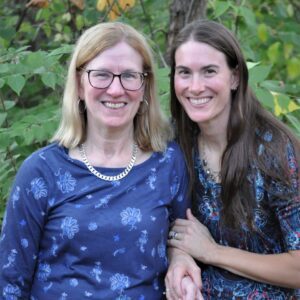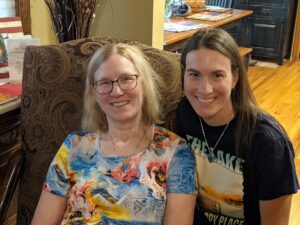
Rare Community Profiles is a Patient Worthy article series of long-form interviews featuring various stakeholders in the rare disease community, such as patients, their families, advocates, scientists, and more.
Unraveling the Genetic Threads: Erin’s Quest to Test for ALSP
Erin Sullivan’s maternal grandmother was 56 years old when she fell ill.
Doctors determined that it was a neurological issue, but no diagnosis seemed to fit perfectly. Early-onset Alzheimer’s disease, they surmised. Perhaps Pick’s disease, a type of dementia. Whatever it was, her grandmother struggled with cognitive and memory issues and often found herself confused. Unfortunately, doctors were unable to treat her; she passed away in 2000.
Erin’s aunt came next. Her condition was also neurological, though the symptoms manifested more in behavioral issues.
Whatever neurological problems were happening, the family took solace in the fact that it didn’t seem genetic. After all, an autopsy of Erin’s grandmother’s brain showed signs of multiple sclerosis (MS).
But everything began to change in 2019 when Erin’s mother—a passionate pianist and organist—suddenly presented with motor issues. Erin watched as her bright and active mother began declining. Her hands wouldn’t respond to stimuli; her gait became shuffled and hunched.

It was then that the family began to understand the underlying health issues that touched members for decades, a journey that ultimately brought an answer: adult-onset leukoencephalopathy with axonal spheroids and pigmented glia (ALSP).
When Erin’s mother was diagnosed, Erin learned that there was a 50% chance that she, too, carried the mutation. She was suddenly faced with a frightening and overwhelming question: if you were at risk of having a terminal illness with no available treatments, would you want to know?
Ultimately, Erin made the choice to pursue genetic testing. She shared with Patient Worthy her family’s story, what ALSP is, and how people can make the right decisions about genetic testing for themselves and their families.
The Journey to Diagnosis
After Erin’s mother got sick, Erin knew that they needed to find an answer. But as many people in the rare disease community know, the journey to diagnosis is often long and arduous, taking multiple years and doctor visits.
They began with a neuro-psychiatric evaluation, and Erin’s mom was initially diagnosed with generalized anxiety disorder. Her symptoms continued to progress. A neurologist found white matter changes and atrophy in brain scans. But according to the treating neurologist, there was no way to tell whether those changes were meaningful. So the family was advised to visit a new facility for additional testing. Erin shares:
“Mom got an appointment, and the plan was to stay for a week for testing and see the neurologist. She was only there for two days before they told her, ‘You have corticobasal degeneration. The prognosis is six years. There’s nothing we can do. Just go and live as best as you can.’ They gave her nothing, literally nothing. No recommendations for medications or therapies. No options in symptom management at all.”
Frustrated by the lack of care, Erin dove into research on corticobasal degeneration and its standard treatments: speech therapy, OT, PT, carbidopa levodopa. The family fought for Erin’s mother to gain access to the treatments—but her condition continued to progress.
After a year, Erin took her mother back to the same facility to see a corticobasal degeneration specialist—an option she said was not offered to the family during their first visit. The doctor looked at the brain scans. The doctor confirmed that Erin’s mom had corticobasal degeneration…but the scans didn’t line up.

Unraveling the Genetics
Genetic testing was recommended, though once again the family faced obstacles in their fight for answers. The frontotemporal dementia (FTD) genetic screening panel came back negative. Doctors then wanted to test for CSF1R, the gene that indicates ALSP, but insurance refused to cover the costs because Erin’s mother was slightly older than the average age of symptom onset.
Her parents decided to pay out-of-pocket for whole genome sequencing. Three years after Erin’s mom’s symptoms had started, the answer finally arrived. She had ALSP. Erin recounts:
“When the genetic results came back, nobody explicitly told us that her diagnosis had changed. I figured it out because I saw the line change from corticobasal degeneration to ALSP on the online documents in her medical portal. But nobody sat us down to tell us what ALSP was and what they knew about it. The research, finding support, the clinical trials—all of that fell on our shoulders. Unfortunately, by that time, she was too ill to participate in any of the natural history studies or research.”
What is Adult-Onset Leukoencephalopathy with Axonal Spheroids and Pigmented Glia (ALSP)?
The National Organization for Rare Disorders (NORD) describes ALSP as:
“A rare, progressive neurological disease that causes brain tissue known as white matter to waste away, forming lesions in certain brain areas. Symptoms of ALSP overlap with frontotemporal dementia and other disorders…such as Parkinson’s disease, multiple sclerosis, schizophrenia, and several others, making diagnosis difficult unless genetic testing is done.”
ALSP affects an estimated 10,000 people in the United States with an average age of onset of 43 years old. Symptoms, which can vary considerably from person-to-person, even among members of the same family, may include:
- Changes in motor function such as slowed movement, falling, or difficulty walking
- Changes in mood, behavior, or personality such as apathy, irritability, loss of inhibition, anxiety, or depression
- Overactive reflexes (hyperreflexia)
- Memory loss
- Aphasia (difficulties with finding words and language)
- Muscle spasms and spasticity
- Weakness on one side of the body or in the limbs
- Reduced coordination
- Dysphagia (difficulty swallowing)
- Poor attention, judgment, and/or problem-solving
- Seizures
- Loss of bladder and bowel control
Unfortunately, there are no FDA-approved treatments or cures. There is currently ongoing research into treatments for ALSP including a phase 2 clinical trial and a natural history study.
Conflicting Emotions
When Erin began looking into ALSP, she learned that it is an autosomal dominant genetic disorder. This means that someone needs to inherit only one copy of the defective gene to become ill; each child of a parent with ALSP has a 50% chance of inheriting the disease. Erin explains:
“Learning about my mother’s diagnosis was partially a relief. We had been grappling with this question of whether our family had a genetic disease for 30 years. Finally, we knew what was going on. If someone else got sick we didn’t have to go through a process of, ‘What is it?’ At the same time, we have a large family. I had to come to the realization that our family is at risk. I have two aunts, a brother, and three cousins at risk. And depending on who is positive, there are even more. It isn’t if and when the shoe might drop; it’s ‘who’s next?’ because statistically there will be a next.”
Suddenly, Erin found herself grappling with a decision. Should she get tested and learn whether she too carried the mutation? Or should she not? Either way, she shares, the family had to come to terms with their newly unveiled reality.
To Erin, genetic testing just made sense. She wanted to understand her family’s history, what her mom was going through, and her own risk. But when she tried to move forward with testing, she was faced with disappointment. The first genetic counselor she spoke with knew almost nothing about ALSP. Instead of receiving counseling, Erin spent her appointment educating the counselor about the disease. It was then, Erin says, that:
“She told me that I shouldn’t do the test and she did not recommend it because I was so young. Instead, I was told to speak with an expert to better understand the disease and risk. I didn’t need to speak with an expert. I have seen the symptoms and the prognosis first-hand.”
Steadfast in her desire to receive testing, Erin switched course and began pursuing a relationship with a neurologist—but nothing was as simple as it seemed. No experts wanted to speak with her when she didn’t have a genetic test and wasn’t showing symptoms.
The Continued Push for Answers
Searching for community support, Erin started looking online in 2022. Her search brought her to Sisters’ Hope Foundation, a nonprofit organization designed to support families facing ALSP. She felt comforted by this community, by others who understood what her family was going through. Erin also saw the research being done and the call for more people to push the research forward.
In August 2022, Erin’s mother passed away—and Erin knew what she had to do. She shares:
“One of my prayers was that the Lord would bring good from my mother’s sufferings. And I knew at that moment that if I carried the mutation, I’d want good to come from that too. So, I signed up for genetic testing.”
After almost a year and half into her genetic testing journey, Erin connected with a program called ALSPAware. The program, developed through the efforts of Sisters’ Hope and an industry partner, provides eligible participants access at no cost to testing and genetic counseling by counsellors who have been educated on ALSP. Through the program, Erin felt comfortable that she would be provided with the tools and support she needed, no matter what her results showed.
The day she was to receive the results came. Erin and her husband sat across from a genetic counselor who held the results in her hand. Was Erin sure that she wanted to know the results?
The counselor waited.
Erin was sure.
Your test is negative.
Erin shares:
“Nobody can prepare you for that moment. My husband and I just hugged each other and cried. I felt extreme relief that I don’t have that future. That my kids don’t have to grapple with it. But I cried for my mom and for my family. Right alongside the relief was deep guilt and sadness. Part of it is irrational—’if I don’t have it, then other people in my family have a greater chance.’ That guilt, even if irrational, is so intense. I honestly thought I had that gene.”
While Erin pursued testing, nobody else in her family is interested in pursuing testing at this time. She says:
“It’s a personal decision and I respect that. But if they’re ever ready, I’m happy to walk them through. Regardless of the results and who carries this mutation, I will love and support them, and we will get through it together. That’s part of why I’m so passionate about my work with Sisters’ Hope. I want to get ready so that when ALSP rears its head in my family, or my community, I can help get everyone in the best possible position.”
Sisters’ Hope
In 2023, Heidi Edwards, the President and Founder of the Sisters’ Hope Foundation, asked if Erin would be interested in running monthly support meetings. Erin eagerly jumped at the chance, holding caregiver and patient support meetings to discuss topics like home health representatives, grief counseling and anticipatory grief, financial advising, and the importance of end-of-life documents.
By June, Erin began as Project Manager of the Cure ALSP division of Sisters’ Hope. From preparing to launch a blog in 2024 as part of an awareness campaign to building out the first global scientific advisory council, Erin has made huge strides. She shares:
“We’re very fortunate that there is a lot of momentum currently in the ALSP space. Companies are researching gene editing. There’s a Phase 2 clinical trial for an infusion with hopes that it slows the progression of the disease. Ultimately, we’re working to tackle issues so that our patients can get faster diagnoses, better care, and—one day—a cure.”
Offering Advice
When Erin thinks back on her family’s journey, she can’t help but wish that they had been given more assistance and support along the way. She says:
“During my mother’s illness, I can’t think of one doctor or clinician who was helpful in symptom management, care, mental health, or planning. We just had to fight and muddle through alone. What tools are available? How do you help a person with incontinence? How do you transfer someone from a wheelchair to a chair to a recliner? It’s really hard on a family and caregiver when they’re already overwhelmed. I urge all doctors to really consider the needs of the people you’re helping and to proactively, not reactively, offer assistance.”
For those who are grappling with their own choices of genetic testing, or who are dealing with a new ALSP diagnosis within the family, Erin also reminds them that they are not alone:
“Testing is a personal choice, but it’s a great time to be tested because there are so many opportunities to participate in research and work towards a cure. If your test is positive, our team at Sisters’ Hope has built out protocols. We can connect you with experts. We’re here to give you hope. You’re not alone. You don’t have to do this by yourself. There is a community here that loves and supports you.”






